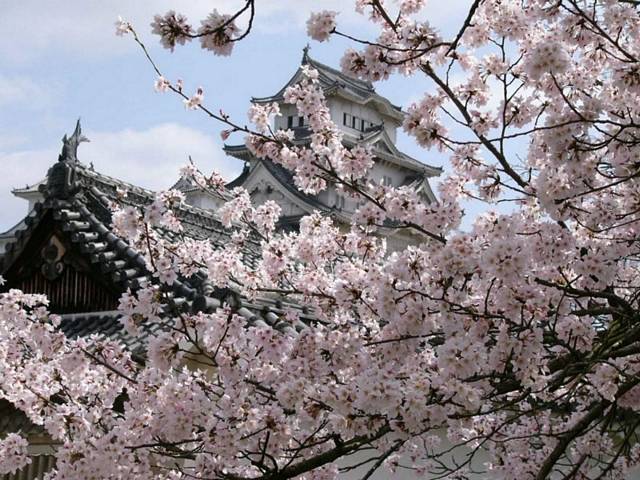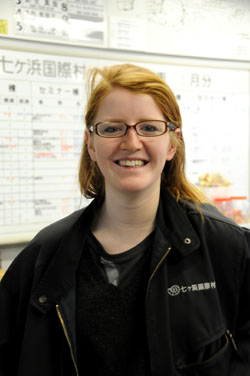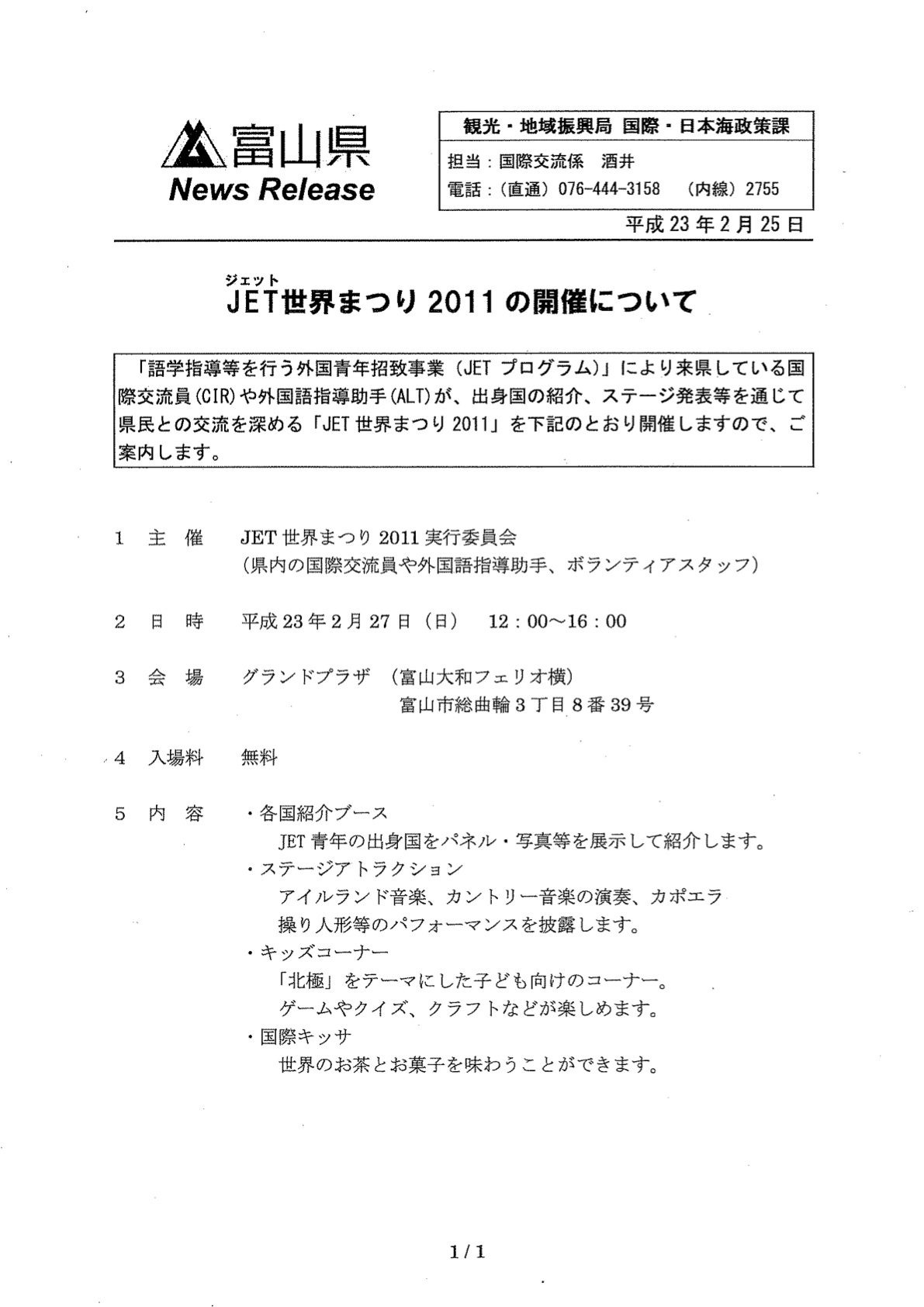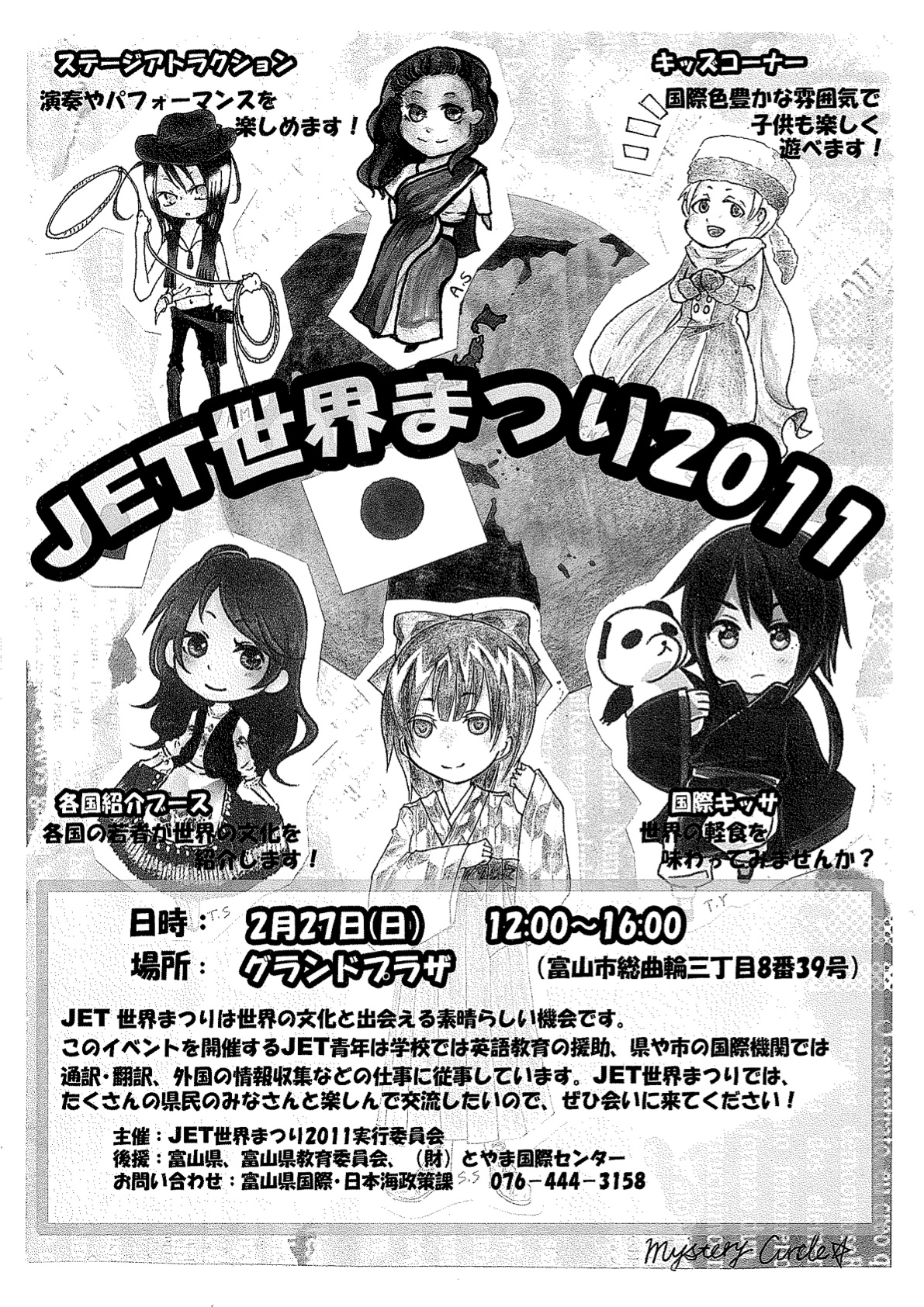*************
Here’s an April 7 Japan Times article about Marti McElreath (CIR Miyagi-ken, Shichigahama-shi).
JET post best, not ‘pityfest’
American helps, refuses to leave beloved, battered beach locale
Thursday, April 7, 2011
SHICHIGAHAMA, Miyagi Pref. — There is a picture folder in Marti McElreath’s Facebook account that chronicles her time in Shichigahama, a town located on a small peninsula in Miyagi Prefecture less than an hour’s drive from Sendai and where she has been working since last summer under the Japan Exchange and Teaching Program.
Her comment on the folder reads: “I have the best JET placement in Japan,” a view McElreath hasn’t changed despite the massive earthquake and tsunami that brutally transformed the once peaceful beach community she has come to love.
“I mean, it’s heartbreaking and hard to see what happened, but people are laughing and kids are playing and life is going on. Even after all that’s happened, I still believe it, I believe that I have the best JET placement in Japan,” she said.
While radiation fears from the Fukushima No. 1 nuclear power plant have led many foreigners in the region to flee, McElreath, who said the town lies on the cusp of the 80-km evacuation zone recommended by the U.S. government, has remained firm in her conviction to stay and do what she can to help the community.
“I’ve only been here for seven or eight months, but I really do love Shichigahama. The people here have been really amazing to me, and they’ve done so much to help me — I couldn’t imagine just leaving,” said McElreath, 23, from Westborough, Mass.
The earthquake and tsunami that hit the small town of 20,000 claimed 56 lives, and 18 people remain missing. Nearly 1,000 people were still living in the town’s six evacuation centers as of Tuesday, and many houses in the coastal area were swept away or damaged.
The facility McElreath works for, Kokusaimura, or International Village, is being used as a temporary shelter, providing food and a place to sleep for around 300 people, and McElreath spends her days helping out evacuees as the only foreigner among the staff.
According to the International Affairs Division of the Miyagi Prefectural Government, out of the 70 JETs in Miyagi — excluding those in Sendai — 36 have either returned to their homeland or evacuated from the prefecture following the earthquake and subsequent nuclear disaster.
A municipal representative from Sendai said out of the 70 JET assistant-language teachers working in the city, 50 remained, and the rest planned to return before schools reopen Monday.
When the magnitude 9.0 earthquake hit at 2:46 p.m. on March 11, McElreath was at her office at Kokusaimura, going about her usual business.
As a coordinator for international relations, McElreath, fluent in Japanese after studying as an exchange student in Kobe during high school and then at Tohoku University during her senior year in college, was responsible for organizing various community events the facility hosted, as well as giving English-language and culture classes to local residents.
Without warning, the earthquake cut off the lifelines at the facility, and while sirens blared out tsunami warnings, people began evacuating to Kokusaimura, which sits on a hill.
McElreath said no one at the facility at that point was aware of the scale of the tsunami that was about to crash into the peninsula. By the time emergency electric generators were able to re-connect television sets, evacuees were confronted with horrific images of the disaster.
“I think it was around that point that we realized that we were going to be here for a while,” she recalled.
Then at around 6 or 7 p.m. a huge explosion shook the facility and its residents as the JX Nippon Oil & Energy Corp.’s Sendai oil refinery, located a few kilometers from Shichigahama, went up in flames.
“The entire sky went red, and everyone gathered around the windows and looked outside and it was, like, an inferno,” McElreath said, adding the smoke from the refinery lasted two or three days.
While McElreath was able to notify a prefectural adviser of the JET program of her safety immediately after the earthquake, cell phone reception quickly died.
It was not until the third day after the earthquake that she rode her bicycle 6 or 7 km toward Sendai and her cell phone finally re-connected, allowing her to contact family and friends to let them know she was safe.
McElreath said that as the Fukushima nuclear disaster unfolded, many foreigners she knew in the region, including non-JETs and those from other nations, were contacted by their respective embassies and advised to evacuate.
“There are noticeably less foreigners, there is almost no one left that you can tell by just walking around,” McElreath said, adding she did not feel threatened by the radioactivity leaking in Fukushima.
“I decided that I would rather stay here as long as possible and keep on monitoring the situation,” she said, adding that while her parents are concerned for her safety, they understand her desire to remain and help the community.
While electricity returned about a week after the earthquake, and propane could be used, water remained undrinkable and was only restored Tuesday in some areas of town. McElreath said that while Kokusaimura was well stocked with food and drinking water, evacuees missed taking baths.
Meanwhile, McElreath said Plymouth, Mass., Shichigahama’s sister city, has been making fundraising efforts, already gathering $80,000 to be used in the town’s rebuilding. Teams from as far afield as Turkey have arrived on search and rescue missions, and various volunteers, including many celebrities, make the rounds to Kokusaimura to drop off goods and cheer up the evacuees.
McElreath has recontracted with JET until July 2012, and she is determined to stay and work — if the situation allows her to — for the entire duration.
“I’d like to let everyone know that the people here are positive and we don’t want this to become a pityfest.
“We are doing our best.”
Surviving in Japan: How to Find (Good) Toothpaste in Japan
Posted by Ashley Thompson (Shizuoka-ken, 2008-2010) of Surviving in Japan: without much Japanese and Lifelines columnist for The Japan Times.
Another one of those “living in Japan” myths claims that Japanese toothpaste generally doesn’t work. Or that it doesn’t contain fluoride. And some folks go so far as to insist this is one of the main reasons why Japanese people have bad teeth. (I hope you realize this is a generalization, and not one that I came up with nor believe!) Of course I bought into this myth, although a few people mentioned something about Aquafresh toothpaste, and brought four tubes with me from the States. Nothing wrong with bringing toothpaste with you, but you certainly don’t need to waste luggage space on it. So let’s delve into toothpaste.

The toothpaste I’m going to examine here is Aquafresh, although some other brands offer similar ingredients. I browsed a local daily goods store and discovered that about two-thirds of the products listed fluoride as an active ingredient. Granted, most toothpaste probably did lack fluoride years ago as well as other ingredients of “modern” toothpaste, but it seems that many brands have caught up now. So first, some words to know: — CLICK HERE to read the rest of the post.
Surviving In Japan: How to Find Out How Fast Your Laundry Will Dry
Posted by Ashley Thompson (Shizuoka-ken, 2008-2010) of Surviving in Japan: without much Japanese and Lifelines columnist for The Japan Times.
You probably already know that most people in Japan hang out their laundry to dry. Drive or ride past apartment buildings on a sunny day and you’ll see clothes, towels, blankets and futons hanging from bars and draped over the rail. And what could be better than to have the sun dry and naturally remove odors and stains from your items? It’s a wonderful thing. Well, at least when you don’t have the strong winter wind like here in Shizuoka attempting to throw your stuff over the ledge (I’ve gotten quite clever at coming up with ways to keep things from blowing off the balcony).
And you probably also know that you wouldn’t hang clothes outside if it’s raining or looks like it’s going to rain.
But what if you could know how fast your clothes might dry on any given day?
There’s a neat tool on various weather websites that determines a “laundry index” or 洗濯指数 (せんたくしすう, sentaku shisuu) – essentially it tells you if it’s a good day for hanging out laundry or not and how quickly certain items will dry.
For this example I’m going to use tenki.jp, though you can find the laundry index on Yahoo and other sites as well (and they are all the same so I can’t say one is better than another).
First, go to tenki.jp, and then click on 指数情報 (しすうじょうほう, shisuu jouhou – sort of like “index information”), as in the picture below. (There’s actually a map of Japan in that blank gray box but it didn’t show up in my screenshot for some reason.)

Next, choose 洗濯 (せんたく, sentaku, laundry). — CLICK HERE to read the rest of the post.
Surviving In Japan: How to Find a Non-smoking Restaurant in Japan
Going out in Japan can sometimes be rough if you’re a non-smoker (like me). Granted, times are changing in Japan, and more and more facilities and areas are now completely non-smoking, or instead have a small room or area designated specifically for smoking. Kanagawa prefecture went completely non-smoking last year, making it the first prefecture in Japan to ban smoking in public areas such as beaches, and various public facilities such as schools and hospitals (though I think both of those are *generally* non-smoking in Japan now anyway) and even restaurants, if the restaurant didn’t already have separated smoking/non-smoking areas. At times, I wish I lived in Kanagawa, if only for that.
Now, of course, I mean no offense to anyone who does smoke – it’s all choice and I’m completely fine with that. My only issue is when kids or pregnant women are around or I have to sit and breathe it because of the location I’m in, as I’ve got some extremely annoying allergies (and I just don’t care for it in general). Thus sometimes, eating out can pose a challenge if you are a non-smoker and wish to avoid smoke at all costs.
Yes, smoke-free restaurants exist, as do various restaurants that are divided into smoking/non-smoking areas, but I can guarantee there are also plenty of restaurants that have neither. So if you are a serial non-smoker, you might be lucky to enjoy a good meal without inhaling secondhand smoke, that is, until the person sitting near you lights up. Of course, if it’s a smoking restaurant, you just have to deal with it, because they are well within their rights to smoke – but from experience, it’s also ruined some meals for me, and makes me want to try and avoid it when possible.
This is easier said than done.
The other day, my husband and I were feeling lazy and wanted to go out to eat, although I was feeling a little off that day and didn’t really want to take our chances with the smoking thing. I don’t know if you’ve heard of Tabelog (食べログ), a great restaurant search tool for all over Japan, but it comes in handy for looking up restaurants. I often browse that site, though I noticed most listings in our area did not designate if they were smoking, non-smoking, or if they had separated seating. (Some listings do, but I find it to be hit or miss, depending on location). The only way we could know for sure was to call every place and ask, and after the first few, it does get kind of annoying.

Enter new search. I pulled up Google, this time hoping I could somehow discover some non-smoking restaurants by using those very keywords (smart, I know…).
Lo and behold, I discovered a website called “Kinen Style”, or actually, “禁煙スタイル” (Non-smoking style). — CLICK HERE to read the rest of this post.
Hyogo Prefecture launches its own “HYOGO JET Alumni Network”
Thank you to Hotaka Kawasaki of CLAIR NY for passing on this information.
Hyogo Prefecture has launched its own HYOGO JET Alumni Network! The current number of JET participants registered on the network is 555. The total number of JET participants in Hyogo prefecture over the last twenty-four years exceeds 5,000.
If you know anyone who doesn’t know about the Hyogo JET Alumni Network, please let him/her know, or just contact Hyogo prefecture.
CONTACT:
Makiko Nagasawa, Hannah Starr and Jeremy Pichot
International Exchange Section, International Relations Division
TEL: 078-362-9017
E-mail: kokusaikoryu@pref.hyogo.lg.jp
*Please note that this is distinct from the Hyogo JET Alum LinkedIn group set up by JetWit. And while the JetWit version has its role, JetWit encourages all Hyogo JET alums to register for the official HYOGO JET Alumni Network via the above contact information. The easier it is for prefecture governments to stay in touch with their JET alumni, the more likely they are to continue to hire JETs.
Matthew Cook (Osaka-fu, 2007-Present) has been elected as National AJET Chair for the 2011-2012 JET year. Cook has been particularly focused on the challenges faced by the JET Program to its future existence.
According to fellow Osaka JET Cailin Arena (2008-Present):
“Matt has spent the past year completely re-defining Osaka AJET. He and the other members have taken the organization in a new direction – using events planning and fundraising to promote JET within their community, which has been experiencing a diminishing number of requests for JETs every year. In just the past 10 months, Osaka has set up volunteer relationships with local orphanages and public service workers, and it has begun developing a study abroad scholarship for students of JET teachers. AJET has been working hard to show Osaka exactly what the benefits of choosing JET are.”
In addition to his work with AJET, Cook has been extremely active within his Board of Education, developing an English curriculum to help Japanese teachers make the transition to elementary school English education as easy as possible. Using his experiences as both a mid-year conference presenter and Tokyo Orientation presenter, Cook will also be leading training seminars this spring. Together with AJET, he hopes to bring support to both JETs and their contracting organizations.
For more detailed information on Cook’s plans for AJET, please visit the AJET website and read his campaign platform: http://ajet.net/lang/en/about/ajet-elections/2011-2012-executive-candidate-platforms/
You can also visit his discussion page to voice any opinions you have about the direction you’d like to see AJET go: http://www.facebook.com/MCookAJET
Osaka AJET is also on Twitter and Facebook. Follow us to join the discussion! http://twitter.com/OsakaAJET
Cherry Blossom Guide for Japan 2011
 I just saw this in the AJET March 2011 eBulletin and thought it might be useful to JetWit readers as well (or at least induce natsukashii feelings):
I just saw this in the AJET March 2011 eBulletin and thought it might be useful to JetWit readers as well (or at least induce natsukashii feelings):
The Sakura Guide
Here are the predicted dates for the sakura first blossom opening and full bloom across Japan (for major cherry blossom sites in each prefecture). If you are travelling around, make the most of each prefecture!
Kyushu Area:
Okinawa: Finished (Early February)
Kagoshima: Open: 1st April Full Bloom: 10th April
Miyazaki: Open: 22nd March Full Bloom: 30th March
Oita: Open: 22nd March Full Bloom: 30th March
Kumamoto: Open: 21st March Full Bloom: 30th March
Nagasaki: Open: 22nd March Full Bloom: 31st March
Saga: Open: 22nd March Full Bloom: 31st March
Fukuoka: Open: 21st March Full Bloom: 30th March
Chugoku/Shikoku Area:
Kochi: Open: 20th March Full Bloom: 28th March
Ehime: Open: 25th March Full Bloom: 2nd April
Kagawa: Open: 25th March Full Bloom: 2nd April
Tokushima: Open: 28th March Full Bloom: 4th April
Yamaguchi: Open: 26th March Full Bloom: 3rd April
Hiroshima: Open: 26th March Full Bloom: 3rd April
Shimane: Open: 29th March Full Bloom: 6th April
Okayama: Open: 26th March Full Bloom: 3rd April
Tottori: Open: 30th March Full Bloom: 7th April
Kinki Area:
Wakayama: Open: 27th March Full Bloom: 4th April
Nara: Open: 28th March Full Bloom: 4th April
Hyogo: Open: 28th March Full Bloom: 5th April
Osaka: Open: 26th March Full Bloom: 3rd April
Kyoto: Open: 31st March Full Bloom: 7th April
Shiga: Open: 2nd April Full Bloom: 9th April
Mie: Open: 30th March Full Bloom: 6th April
Chubu Area:
Aichi: Open: 25th March Full Bloom: 2nd April
Shizuoka: Open: 26th March Full Bloom: 3rd April
Gifu: Open: 31st March Full Bloom: 7th April
Nagano: Open: 7th April Full Bloom: 13th April
Yamanashi: Open: 28th March Full Bloom: 5th April
Fukui: Open: 3rd April Full Bloom: 10th April
Ishikawa: Open: 4th April Full Bloom: 11th April
Toyama: Open: 3rd April Full Bloom: 10th April
Niigata: Open: 9th April Full Bloom: 15th April
Kanto:
Kanagawa: Open: 23rd March Full Bloom: 31st March
Tokyo: Open: 24th March Full Bloom: 1st April
Chiba: Open: 29th March Full Bloom: 5th April
Saitama: Open: 26th March Full Bloom: 2nd April
Gunma: Open: 29th March Full Bloom: 5th April
Tochigi: Open: 31st March Full Bloom: 6th April
Ibaraki: Open: 5th April Full Bloom: 13th April
Hokkaido/Tohoku Area:
Fukushima: Open: 8th April Full Bloom: 14th April
Yamagata: Open: 15th April Full Bloom: 21st April
Akita: Open: 24th April Full Bloom: 29th April
Miyagi: Open: 10th April Full Bloom: 16th April
Iwate: Open: 19th April Full Bloom: 25th April
Aomori: Open: 22nd April Full Bloom: 27th April
Hokkaido: Open: 1st May Full Bloom: 5th May
JET World Festival Held in Toyama
Thanks to Hotaka Kawasaki and Matt Gillam of CLAIR-NY for sharing news about this nice example of “Return on JET-vestment” at the local government level:
The CIRs and ALTs in Toyama held the JET World Festival 2011 in Toyama City on February 27th to celebrate their respective home countries and deepen relations with the people of Toyama. According to the Japanese news release below, the festival included booths for each country as well as stage shows featuring Irish music, country & western music, capoeira, and puppet performances. The festival also included a “North Pole” themed kids’ corner and a refreshment stand.
How was the festival? Please feel free to tell us more in a comment to this post or via e-mail to jetwit [at] jetwit.com.
Cooking in Japan: Share your stories!
Update: See submitted stories further below in this post! Additional ones will be added as received. So keep checking back.
I learned recently from our friends at the free Japanese weekly Shukan NY Seikatsu that “food” is the leading driver of tourism to Japan from the U.S. these days. With that in mind, I thought it might be helpful (not to mention oishii and natsukashii) if the JET and JET alum community were to share personal anecdotes about cooking while living in Japan.
- E-mail responses to Steven at jetwit [at] jetwit.com.
- Please make sure to include your prefecture, city/town and years on JET in the following format: Steven Horowitz (Aichi-ken, Kariya-shi, 1992-94)
- Responses can be as short as once sentence and as long as 5 paragraphs. (*If you want to write something longer, that’s great too. I just suggest checking with me first to get on the same page before spending a lot of time and effort writing.)
- Responses will be aggregated into one easy-to-read post.
- Yes, this is one more project intended to help boost the “return on JET-vestment” for local governments as well as for Japan on the whole.
Itadakimasu!
***********
Stories of Cooking in Japan
Japan Local: Yadoriki Village in the Kanagawa mountains
“Japan Local“ is a new feature intended to share the small town Japan experience with potential visitors and tourists. If you have videos or photos or writing about your town, please feel free to submit to jetwit [at] jetwit.com.
Thanks to JETAA Tokyo President Byron Nagy for sharing this video titled “Experience Yadoriki in Under a Minute,” made by a Friend of JET (or a “JET in spirit” to borrow Byron’s phrasing):







